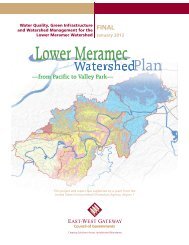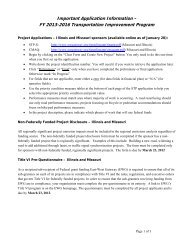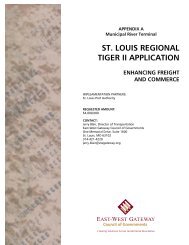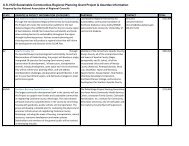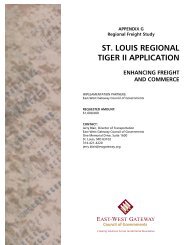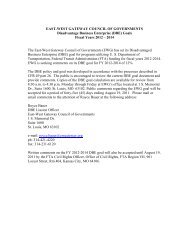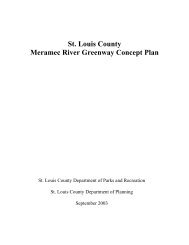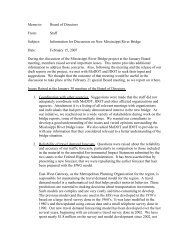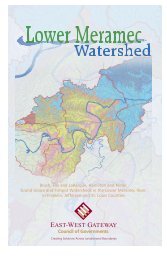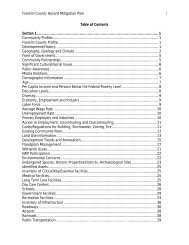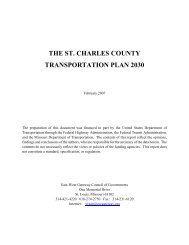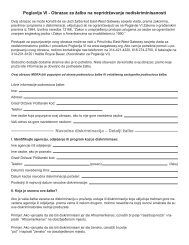Jefferson County - East-West Gateway Coordinating Council
Jefferson County - East-West Gateway Coordinating Council
Jefferson County - East-West Gateway Coordinating Council
Create successful ePaper yourself
Turn your PDF publications into a flip-book with our unique Google optimized e-Paper software.
A Regional Overview All-Hazard Mitigation Plan 1<br />
SECTION 2<br />
Risk Assessment<br />
Hazard Identification and Elimination Process<br />
During the course of this study, many sources were researched for data relating to hazards.<br />
Primary sources included FEMA, SEMA, National Climate Data Center (NCDC) and the<br />
National Oceanic and Atmospheric Administration (NOAA). The U.S. Geological Survey<br />
(USGS) and Center for Earthquake Research and Information (CERI), Central U.S.<br />
Earthquake Consortium (CUSEC) were major sources for earthquake information. MDNR’s<br />
Dam and Reservoir Safety Program provided major information concerning dams.<br />
Additional research was based on data from USACE, National Park Service, National Forest<br />
Service, other departments within Missouri Department of Natural Resources, St. Louis<br />
University, State of Missouri Climatologist, Missouri Department of Conservation, and<br />
University of Missouri, Columbia. Additional sources included county officials; existing<br />
county, regional and state plans, reports on the floods of 1993 and 1995; position papers<br />
on transportation issues and information from local officials and residents. Past State and<br />
federal disaster designations, current Flood Insurance Rate Maps (FIRMS) and available local<br />
mitigation plans were also utilized.<br />
In order to identify the hazards relevant to <strong>Jefferson</strong> <strong>County</strong>, the above information sources<br />
were searched for incidents of all possible hazards occurring within the county. Some<br />
hazards are regional in scope and included in the hazard profiles. Location-specific hazards<br />
not found through the information search were further investigated to determine whether<br />
there would be a future possibility of occurrence. Hazard event histories, repetitive loss<br />
information and conversations with local residents were used to identify relevant hazards.<br />
Community-Wide Hazard Profile and List of Hazards Identified<br />
The largest disaster to impact <strong>Jefferson</strong> <strong>County</strong> in the recent past was the Great Flood of<br />
1993. The loss of homes, businesses and infrastructures, as well as the temporary closing<br />
of some local businesses, contributed to economic losses throughout the <strong>County</strong> and<br />
beyond. Several hazards can affect <strong>Jefferson</strong> <strong>County</strong>. History indicates that <strong>Jefferson</strong><br />
<strong>County</strong> could be at risk of tornadoes and severe thunderstorms, riverine flooding (including<br />
flash flooding), severe winter weather (snow, ice, extreme cold), drought, heat wave,<br />
earthquakes, wildfires and dam failures. Worksheet #1, <strong>Jefferson</strong> <strong>County</strong> Hazard<br />
Identification and Analysis, is included at the end of the Technical Appendix and shows<br />
earthquakes as the hazard with the greatest possible impact. <strong>Jefferson</strong> <strong>County</strong> has<br />
experienced a number of slight tremors from the New Madrid Fault Zone. Disasters ranked<br />
in descending order after earthquakes include flood, dam, severe windstorms, winter<br />
weather, drought, wildfires, and heat wave.



